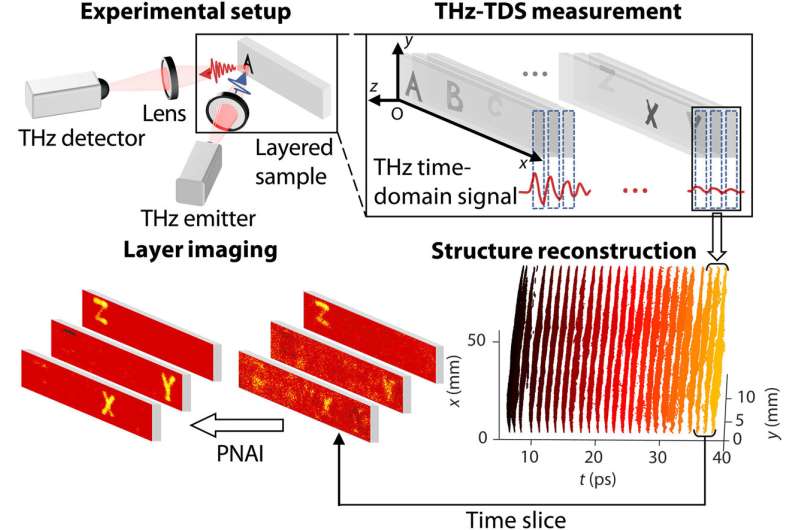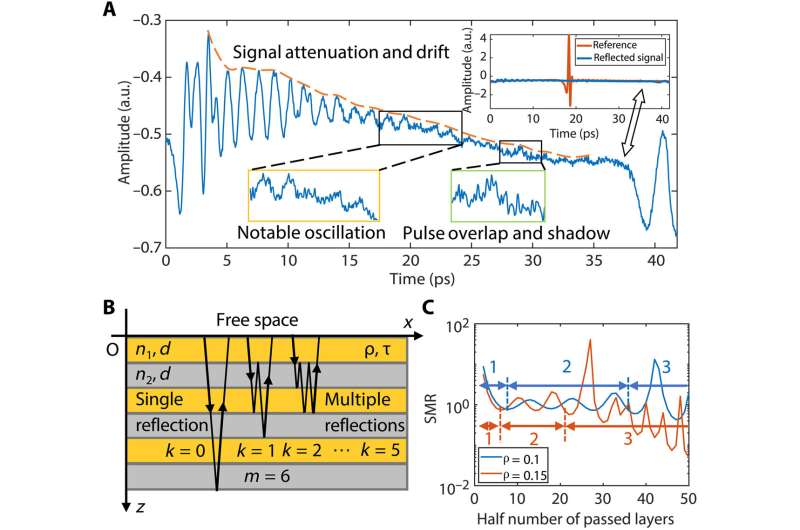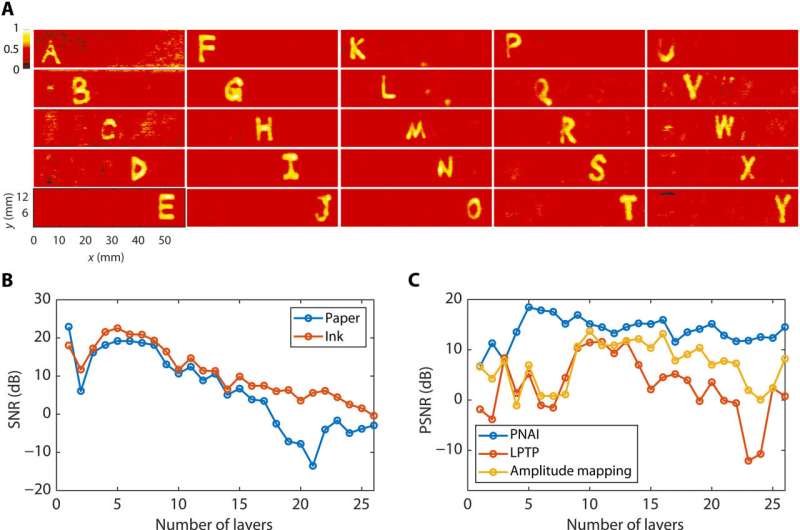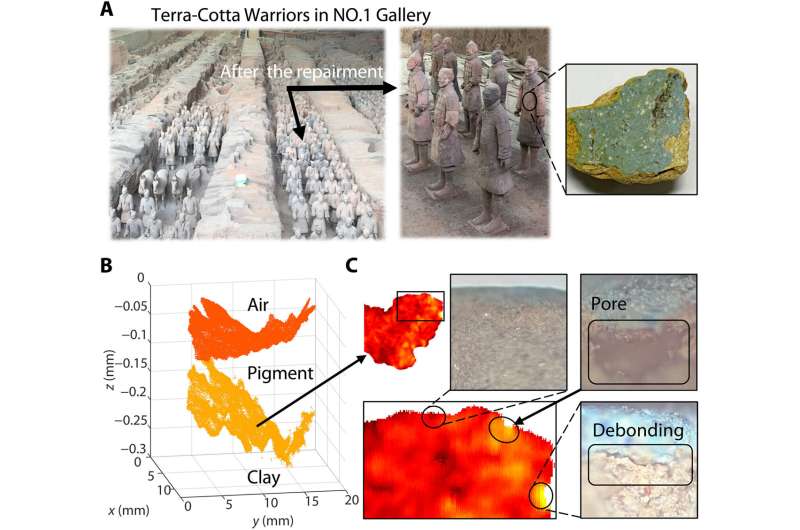October 18, 2023 feature
This article has been reviewed according to Science X's editorial process and policies. Editors have highlighted the following attributes while ensuring the content's credibility:
fact-checked
peer-reviewed publication
trusted source
proofread
Hidden information extraction from layered structures through terahertz imaging

Noninvasive inspection of layered structures is challenging for time-resolved imaging methods, where the resolution and contrast can be compromised by prominent signal attenuation with interlayer reflections and dispersions.
In a new report on Science Advances, Yuqing Cui and a team of scientists in manufacturing systems engineering, electrical and computer engineering and chemistry in China, U.K., and U.S., introduced a method based on terahertz time-domain spectroscopy to attenuate the limits through fine resolution and a broadband spectrum, to extract hidden structural and content information from layered structures.
To accomplish this, they studied the local symmetrical characteristics of reflected Terahertz pulses to determine the location of each layer and enhanced the image contrast to evidence its superior performance. The scientists noted the extraction of alphabetic characters in a 26-layer subwavelength. The work allowed Cui and colleagues to accurately reconstitute the structure and high contrast imaging at ultralow signal to noise ratios, to inspect the internal architecture of cultural artifacts, coatings, and composites.
Terahertz time-domain spectroscopy (THz-TDS)
Scientists typically conduct imaging in the terahertz band due to its nonionizing nature, and the high degree of transparency in nonpolar dielectrics. Terahertz time-domain spectroscopy is a nondestructive spectroscopic testing method with 3D imaging, to examine the properties of samples using short pulses of terahertz electromagnetic radiation. The method provides fine resolution and a broadband spectral signature when compared with X-ray tomography and ultrasonic techniques that are suitable to inspect layered structures such as cultural artifacts, pharmaceutical drugs, and composite structures.

Nevertheless, the method can be challenging for broad practical applications due to its sub-milliwatt power that is too feeble to penetrate deeply layered materials for information extraction. This is also accompanied with a drop in the signal-to-noise ratio with numerous small pulses to make imaging challenging to detect the position and amplitude of terahertz pulses. In this work, Cui and colleagues proposed a new method for hidden information extraction from layered structures due to an ultralow signal-to-noise ratio. The approach provides an innovative inspection method with high image contrast and profound penetration depth to examine layered structures.
Measurement setup and processing framework
The team inducted experiments with a pair of photoconductive antennas set in a reflection geometry to measure a 30-layer stack of paper, comprised of alphabetical letters. The emitted terahertz pulse through the lens concentrated in the sample, while the reflected terahertz signal consisted of a sequence of pulses originating at various interfaces, to capture and reflect the terahertz signal and provide time-of-flight and reflectivity information.
The scientists carried out signal analysis and physical explanations, to note signal attenuation due to the confocal setup of the instrument, water-vapor absorption, and transmission absorption in the paper stack. Cui and team explored the signal analysis and reflection model.

Layer-structure reconstruction
To examine layered samples with the THZ-TDS technique, the team used pulse position to reconstruct layer structure and understand the appropriate timeframe to conduct transverse imaging. While the appropriate extraction of the pulse position partially determined the image quality, the complex terahertz signals underwent reflection from structures with dozens of layers. Cui et al. additionally developed a pulse extraction algorithm known as local symmetry peak finding.
The scientists compared the results among different pulse extraction techniques. Following the peak finding of pulse sequences, they successfully extracted layer interfaces from point clouds to reconstruct the structure of layered samples. Afterwards, they obtained transverse terahertz images within various layers by extracting amplitude information from corresponding pulses.
The team used a method for average-amplitude terahertz imaging named the pulse neighborhood average imaging method to obtain high-contrast terahertz images from structures with dozens of layers, with excellent consistency and imaging quality. The team explored the capacity of the proposed method by writing nine words from layers three to 19 of a 22-layer paper stack and conducted terahertz imaging to clearly recognize all the words.

Applications to decipher cultural heritage
Cui and colleagues next examined cultural artifacts such as murals or canvas paintings with layered structures to detect internal defects and hidden paint layers of artworks to gather hidden information of the structures. The team accomplished this and examined the potential to study the structure and aging conditions of 8000 Terra-Cotta warriors of the Emperor Qin Shi Huang Mausoleum in X'ian to protect and repair the figures. The proposed method successfully examined the structure, its internal defects, and hidden content to obtain hidden information of rich cultural heritage value.
In this way, Yuqing Cui and colleagues used terahertz pulses and pulse neighborhood average imaging to obtain high contrast, terahertz images with noise elimination. The proposed framework can extract hidden structural and content information spanning from subwavelength layered paper with high resolution and contrast, to the level of detecting ancient documents—without damage. The method thereby provides fine imaging quality with practical solutions.
More information: Yuqing Cui et al, Hidden-information extraction from layered structures through terahertz imaging down to ultralow SNR, Science Advances (2023). DOI: 10.1126/sciadv.adg8435
Albert Redo-Sanchez et al, Terahertz time-gated spectral imaging for content extraction through layered structures, Nature Communications (2016). DOI: 10.1038/ncomms12665
Journal information: Nature Communications , Science Advances
© 2023 Science X Network




















